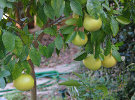Eat Citrus to Help Get Your Diabetes Under Control
Citrus fruit may hold the answer to diabetes management
May 27, 2012 | By Kimberly Day, Contributing Editor, Peak Health Advocate
What could be more commonplace than the orange? We juice it, eat it, decorate it with cloves at the holidays, and even named a color after it.
These little spheres of juiciness also house a rich store of vitamins, minerals, fiber, pectin, and a category of nutrients called flavonoids. This broad class of plant chemicals includes flavanones, flavonols, and phenolic acids, which have been shown to be great anti-inflammatories and antioxidants, while also helping to prevent cancer, blood clots, and bacteria and viruses.
And according to a new study from Preventative Medicine, they can also help in the management of diabetes. [1]
And its not just oranges that confer these amazing health benefits. Lemons, kumquats, and orange relatives such as clementines, tangelos and mandarins, and other citrus fruits have shown tremendous protective abilities. But what is it exactly that makes citrus so powerful?
Its All About the Peel
Research has shown that the bulk of citrus health benefits lie in the peel.[2] In fact, an orange peel contains 136 mg of vitamin C per 100 grams. The fleshy part you eat (the pulp) has only 71 mg.
It doesnt end there. The peel also contains several times the amount of vitamins A and B, calcium, selenium, manganese and zinc than the pulp. And we are literally throwing this all away!
Like your skin, the peel also has several layers. The top layer (the colored part) is called the flavedo. The white inner layer is the albedo.
Like the other nutrients mentioned above, the peel also has the greatest concentration of flavonoids. The three types of flavonoids found in all citrus fruits are:
Flavanones
Flavones
flavonols
A 1998 study found that flavanones in particular are greater in the albedo (the white part), while flavones and flavonols vary in the flavedo (colored part of the peel) and the part you eat.[3] These flavonoids are the juice (pun instead) behind citrus health-protective properties, especially when it comes to diabetes.
Citrus Fruit and Diabetes Management
Several studies have shown that free radical damage and inflammation are hallmarks in type 2 diabetes.[4] [5] In fact, oxidative stress due to free radicals and changes in glucose metabolism are risk factors for diabetes, as well as the subsequent complications.
And then there are advanced glycation end products (AGEs). When blood glucose levels remain elevated for an extended period of time, sticky sugar molecules can attach to protein molecules in a process called glycation. Glycation of protein molecules can lead to new protein structures called AGEs.
AGEs cause a kind of browning or cooking within your cells, which can stimulate inflammatory processes and free radical damage throughout the body. AGEs can also cause your blood vessels to become stiff and lose flexibility. Plus, they can destroy the collagen in your skin, creating premature aging.
As depressing as this sounds, the good news is that citrus extracts have been shown to be powerful antioxidants and anti-inflammatories.[6] [7] Plus, extracts from the tangelo and tangor fruits specifically have been shown to protect against AGEs.[8]
When it comes to glucose metabolism itself, citrus fruits continue to shine. According to a 2006 animal study, citrus extracts not only slow glucose uptake, but also inhibit the movement or transport of glucose through the intestines and liver.[9]
And a 2009 study examining extracts from a Korean citrus fruit called Dangyuja found that it holds great promise for controlling blood glucose levels in diabetic patients.[10]
Given the high flavonoid properties of citrus fruits and the animal studies examined, researchers concluded, Citrus fruit extracts represent an excellent candidate for nutraceuticals and functional foods geared towards the management of diabetes.
Dont Forget the Peel
This research, while very scientific in nature, does a nice job of laying out the why behind the power of citrus fruits and disease. What is even more interesting is that the bulk of the antioxidant power of citrus lies in the peel, which most people discard.
Kumquats
Given this, there are a few things you can do to still reap the power of the citrus:
Zest the peel and add to smoothies, oatmeal or cereal. You can also use while cooking. Be sure to zest the entire peel.
Get to know kumquats. These mini-citrus fruits can be eaten whole, peel and all.
If you do peel other citrus fruits before eating, try to keep as much of the albedo, or white part, as possible.
If you simply cannot stomach the peel in any form, continue to eat citrus fruits and supplement with citrus extract products, which contain the key nutrients found in the peel. Look for products that contain the micronutrients discussed here and take in the dosage recommended on the label. - Millet (A Diabetic)
http://www.peakhealthadvocate.com/3125/citrus-natural-diabetes-management/ 













